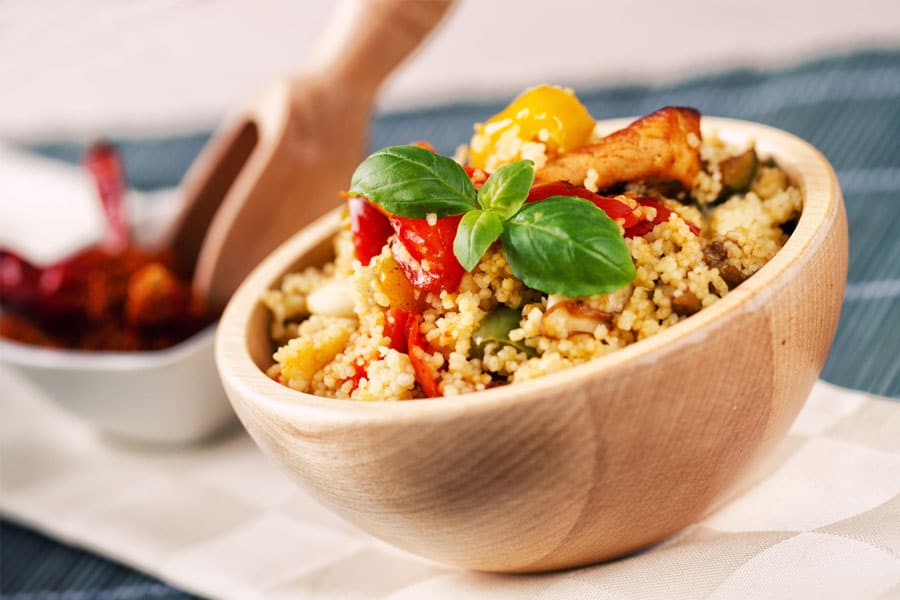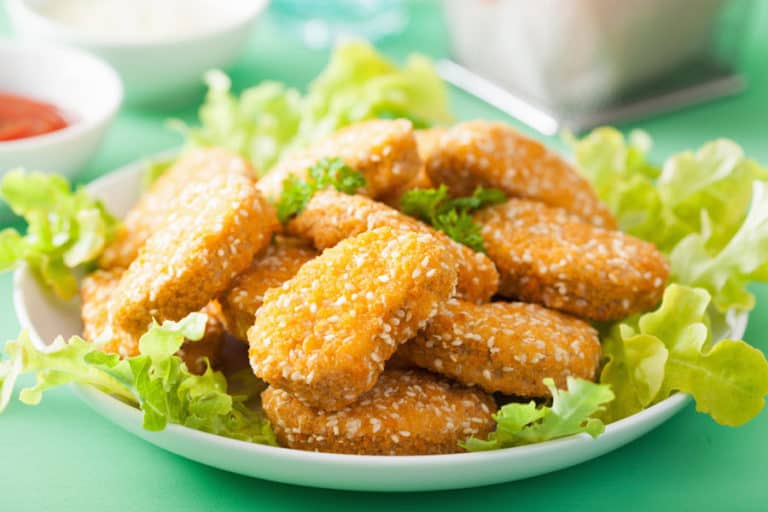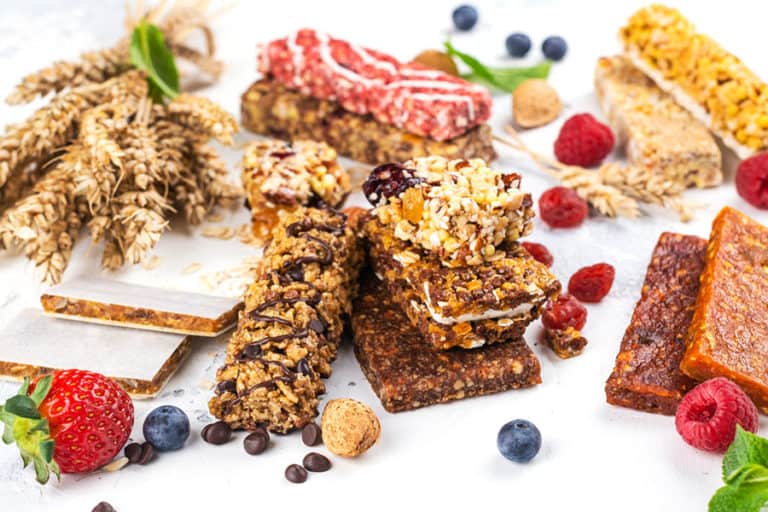Is Couscous Gluten-Free?

is couscous gluten free | how is it made | types | Couscous vs quinoa | Alternatives | gluten free brands | Make at home | nutritional properties
Couscous traces its origins to North Africa. It is made from durum wheat semolina. It has a bland taste which makes it a perfect canvas for other flavors. This is why couscous is a staple food in many North African and Middle Eastern countries.
However, is couscous gluten-free? Can you consume it when following a gluten-free diet? Here is a detailed overview of couscous and its gluten content to help you make an informed decision.
Is couscous gluten free?
No, couscous is not gluten-free [1]Beyond Celiac: Is Couscous Gluten-Free?.
Although it looks like rice and quinoa, couscous is made of wheat and cannot fit into a gluten-free diet.
Any dishes that contain couscous as an ingredient are off-limits to people with celiac disease or non-celiac gluten sensitivity.
How is couscous made?
Couscous is made from semolina wheat flour. Semolina is the coarse, purified wheat middlings of durum wheat.
It is typically a tiny pasta but can also be sold in different shapes and sizes. Couscous is light tan or brown in color, which is why it is sometimes mistaken for brown rice.
To make couscous, durum semolina wheat [2]National Library of Medicine: Durum Wheat Couscous Grains: An Ethnic Mediterranean Food at the Interface of Traditional Domestic Preparation and Industrial Manufacturing is mixed with water and undergoes physical and thermal treatment. The wheat is then crushed and ground into flour.
This flour is then moistened with water and steamed to make them puffy. Once it is cooked, the couscous is dried, and then it is sold in different shapes.
Different types of couscous
There are several types of couscous available in the market. They all have slightly different sizes, flavors, and textures, depending on how they are made. However, there are two types that are more widely available- Moroccan and Israeli.
1. Is Israeli couscous gluten free?
Israeli couscous is not gluten-free. It is also known as ptitim, giant, and pearl couscous. It was created in the 1950s in Israel and is made from toasted semolina wheat flour.
Thus, it is off-limits to people with celiac disease. However, some brands offer gluten-free options of Israeli couscous made with rice, quinoa, or corn.
2. Is Moroccan couscous gluten free?
No, Moroccan couscous is not gluten-free. It is the most common type of couscous. It is made from semolina wheat flour and water. It is then rolled into small pellets. This type of couscous has a chewy texture and is light tan in color.
Difference between couscous and quinoa
Even though couscous and quinoa are both grain-like foods, they are quite different. Here is a list of the differences between these two popular grain-like foods:
| Quinoa | Couscous |
| Made from the seeds of the goosefoot plant | Made from durum wheat semolina flour |
| Naturally gluten-free | Contains gluten |
| Has a nutty and chewy texture | Has a light and fluffy texture |
| Rich in protein and fiber | Low in fat and calories |
Gluten free couscous alternatives list
If you have gluten intolerance, finding gluten-free substitutes for your favorite wheat-based foods can be a challenge. However, there are several delicious gluten-free alternatives available that can be used as a couscous substitute.
A study [3]ResearchGate: Gluten-free couscous preparation: Traditional procedure description and technological feasibility for three rice-leguminous supplemented formulae on the production of rice-leguminous supplemented couscous formulas compared with the traditional durum semolina-based couscous.
The study found that such formulae resulted in a gluten-free couscous with similar color, texture, and cooking properties as the traditional durum semolina-based couscous.
This means that it is possible to make a gluten-free version of couscous. Of course, rice is not the only available alternative here. Let’s look at all the alternatives.
1. Quinoa
Quinoa is a nutrient-rich grain that’s perfect for those on a gluten-free diet. It’s also one of the most versatile ingredients, making it an excellent substitute for couscous in salads, pilafs, and more.
2. Brown rice
Brown rice is another excellent gluten-free alternative to couscous. It has a nutty flavor and chewy texture, making it a perfect substitute for salads, side dishes, and main courses.
3. Sorghum
Sorghum is a gluten-free grain that can be used as a couscous substitute. It is shaped like a round ball and slightly larger than couscous. It has a slightly sweet flavor and firm texture. It is often used to make sourdough bread.
4. Millet
Millet is another gluten-free grain that is perfect for those on a restricted diet. It has a slightly sweet flavor that pairs well with couscous dishes, making it an ideal substitute for sweet and savory recipes.
5. Cauliflower rice
Cauliflower rice is a healthy, low-carb alternative to traditional rice. It can also be used as a couscous substitute. Cauliflower rice has a light and fluffy texture, making it a perfect replacement for couscous in salads, side dishes, and main courses.
Couscous gluten-free brands
Fortunately, there are some great gluten-free couscous brands in the market that make it easy to find a delicious and safe alternative to wheat-based couscous.
Here are some of the best gluten-free couscous brands:
1. Gefen gluten-free couscous
Gefen offers a delicious and easy-to-prepare couscous perfect for those on a restricted diet. It is made with eggs and potato starch. Gefen’s offers 100 % gluten-free couscous certified by the Gluten-Free Certification Organization.
2. Tesco couscous
Tesco’s gluten-free couscous is a quick and easy way to enjoy a delicious meal. It is made with corn maize flour and is ideal for those on a gluten-free diet.
3. Goldbaum’s couscous
Goldbaum’s offers gluten-free Israeli couscous. Their version of couscous is made with egg white, potato starch, and tapioca starch. It has a light and fluffy texture that’s perfect for salads.
4. Streit’s couscous
Kosher foods company Streit’s couscous is a great gluten-free alternative to wheat-based couscous. It is made with potato flakes, egg whites, potato starch, and tapioca starch.
5. Lieber’s gluten-free couscous
Lieber’s gluten-free couscous is made with eggs, potatoes, and several other vegetables. It is a delicious alternative to wheat-based couscous and is perfect for those on a strict gluten-free diet.
Making gluten-free couscous at home
If you’re unable to find gluten-free couscous, you can still prepare couscous dishes at home. You can use alternative gluten-free grains like corn, rice, or quinoa and cook in the same way as traditional couscous.
Here is how you can make couscous at home with quinoa flour.
Ingredients: 1 cup quinoa flour, olive oil, 1.5 cups water, a pinch of salt
- Mix the quinoa flour, olive oil, water, and salt in a bowl.
- Place the mixture in a saucepan and add water to it.
- Stir over medium heat until it comes to a boil.
- Reduce the heat and simmer for about 10-12 minutes, stirring occasionally.
- Remove the pan from the heat and let it cool.
- Once it is cooled, fluff it with a fork.
Note: Once you make your gluten-free couscous, you can cook them the same way as regular couscous.
Couscous nutritional information
Couscous is a good source of protein, fiber, and vitamins. According to U.S. Department of Agriculture (USDA), 100g of couscous contains: [4]U.S. Department of Agriculture: COUSCOUS
- Calories: 357 kcal
- Protein: 11.9g
- Carbohydrates: 71.4g
- Dietary fiber: 4.8g
- Sugar: 2.38g
- Calcium: 48g
- Iron: 2.57g
Conclusion
Although couscous is traditionally made with wheat, several gluten-free options are available on the market. However, if you are on a gluten-free diet, it’s essential to check the label to ensure the couscous you’re purchasing is indeed gluten-free.
Nevertheless, you can make your own gluten-free couscous at home with quinoa, rice, sorghum, etc. Choose any gluten-free grain you like and cook it the same way as traditional couscous.
References
| ↑1 | Beyond Celiac: Is Couscous Gluten-Free? |
|---|---|
| ↑2 | National Library of Medicine: Durum Wheat Couscous Grains: An Ethnic Mediterranean Food at the Interface of Traditional Domestic Preparation and Industrial Manufacturing |
| ↑3 | ResearchGate: Gluten-free couscous preparation: Traditional procedure description and technological feasibility for three rice-leguminous supplemented formulae |
| ↑4 | U.S. Department of Agriculture: COUSCOUS |







